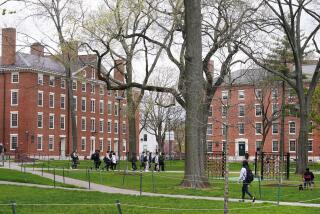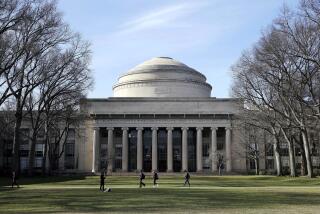One reason tuition keeps soaring? Colleges’ unhealthy obsession with ‘yield’
- Share via
Two years before my youngest was even ready to apply to college in 2014, the letters and packages started coming in the mail. Think about attending our school, they said. We have the prettiest campus. We give merit scholarships. We have more counseling, more extracurriculars, more fountains and a Maya Lin art installation. And really, getting into Harvard might not be as hard as you think. (Sure, it’s not.)
I’d seen a few of these mailings when my eldest came close to college age, a significant stack of envelopes with the second. The third time, I asked her to toss them in a box to see what this looked like at the end. She invited me to just do that myself; she didn’t use marketing materials to decide where to apply. It ended up being more than 300 pieces of mail, with some colleges and universities sending eight or nine mailings. After she received her acceptance emails, new packages — and many more emails — came in. Eyeshades for getting sleep in the dorm, hint hint. Reusable water bottles for hydrating on those long strolls across the gorgeous campus.
It’s all part of the hyperdrive of college admissions that is pushing college costs upward. It’s not something we can afford to keep doing if we want free colleges like in much of Europe, or reduced costs, or even just keeping prices flat.
The marketing is the first step toward bringing in enough applicants to fill university seats. Tours and evening marketing are part of the picture as well. And, as a Times story relates in detail, the next part is about yield — the few weeks during which students choose which school to attend, if they are lucky enough to have a choice.
This issue of choice is not trivial to colleges. Yield — the percentage of accepted students who decide to enroll — is the sleep-robbing, migraine-inducing anxiety source for college administrators throughout the nation.
Figuring out yield — and there are sophisticated algorithms for it — is crucial to filling all the spots, but not too many spots, each fall. UC Irvine went through an ugly episode in 2017 when the yield estimate was far lower than the number who wanted to attend. With no space for them all, university officials resorted to using the flimsiest excuses to rescind the admission of hundreds of those kids. It eventually ’fessed up and reversed course.
It’s easier to keep yield up if there are extras to market to students — the cool dorms or campus amenities, the extra layers of administration to provide non-academic services, the sports, college-sponsored cultural and social events.
All of this costs. In fact, administrative costs at U.S. colleges and universities are a big part of what differentiates them from the European system. But so do the amenities and the sports. You didn’t think college in Germany was just like college here, just splendidly subsidized by government, did you? It’s a very pared-down system of higher education in which most students commute to school, there are few if any sports teams, class sizes are huge, student services are low, student centers generally nonexistent and admission very hard to gain. Marketing and yield are not issues for those schools.
Yield started becoming a bigger deal in the United States when U.S. News & World Report included that figure in its calculations of a school’s ranking. The idea was the more students who chose a school as their first choice, the more prestigious the school was and therefore the better it was. The magazine did away with yield as a factor years ago. But there are fewer college-age students, and more of them are poor. Filling dorms and classes with students is more of a challenge. Which is why the heavy blow of COVID-19 was enough to put a smattering of schools out of business altogether.
As the nation discusses whether to erase up to $50,000 per graduate of student debt, these are factors to keep in mind. There’s more to U.S. college costs than yield and the marketing they do to keep admissions up. But as fun as it feels for students to be in the driver’s seat for once, this is not a healthy way to plan for affordable higher education in America.
More to Read
A cure for the common opinion
Get thought-provoking perspectives with our weekly newsletter.
You may occasionally receive promotional content from the Los Angeles Times.










